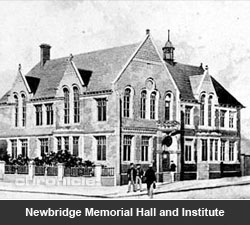
Newbridge Memorial Hall and Institute
In 1898 a group of local miners in Newbridge set up a committee to look at improving the social amenities of their fellow workers. They went in search of a site to house their plans and eventually bought a large, town centre plot from the council.
While most colliery workingmen's clubs were built after the introduction of the Miners Welfare Fund, Celynen was built and paid for by the miners themselves, with subs taken from their wages.
A mortgage was taken out on the site for the building costs of nearly £6,000. With the average miner's wage at around £3 per week and the majority of workers living in rented accommodation, this was a brave move.
At the time of its construction, in 1908, the coal industry was thriving, Celynen Collieries employed around 1,700 men and nobody envisaged what lay ahead. And it was not just the building's architecture that reflected the optimism of the time. With social reform on the political agenda, the miners looked at self-improvement and education, with libraries and reading rooms an integral part of the club.
The cinema was particularly impressive, with ornate fittings and art deco styling. Many of the original features such as the projectors, posters, curtains and frescoes showing mining images, still remain.
Sadly, Celynen Collieries closed in 1985 and the miners lost their jobs and their way of life.
The "Newbridge Memo" and Institute developed into the premier cultural centre in the area with a magnificent 700 seat 'Art Deco' cinema, a large dance hall, a four table billiards room, library and reading rooms, and a variety of other committee meeting rooms and offices for the local Mining Union officials.
Despite falling into decline with the demise of the coal industry, the Institute retains much of its original structure and architectural features. CADW, the Welsh government heritage body, formally acknowledged the importance of the Memo in 2003 when it placed it on its list of significant buildings requiring the protection of the state. The Memorial Hall was listed Grade II, with the description; "Early 20th century Workman's Hall with unusually high quality and exceptionally well preserved cinema auditorium."
Located on the upper floor of the Memorial Hall, the cinema auditorium could seat around 700 people. It still possesses a wonderful grandeur and ambience that continues to shine through, even in its current state of disrepair.
A feature of the interior decoration are the wall paintings depicting industrial scenes with miners toiling underground, and must be unique in the history of the 'picture palaces'. The Memo is all the more remarkable because it has managed to retain many of its original facilities and equipment, including 2 carbon arc film projectors, ticket booth and managers office, light fittings and the dressing rooms that served the main auditorium and dance hall.
Image date: unknown
Location: unknown
Submitted by: unknown
Do you have any stories, images and interesting facts relating to this picture. Help Chronicle build a website of your Caerphilly County Borough memories. Email the webmaster telling us as much as you can about your pictures. Thank you
Description: